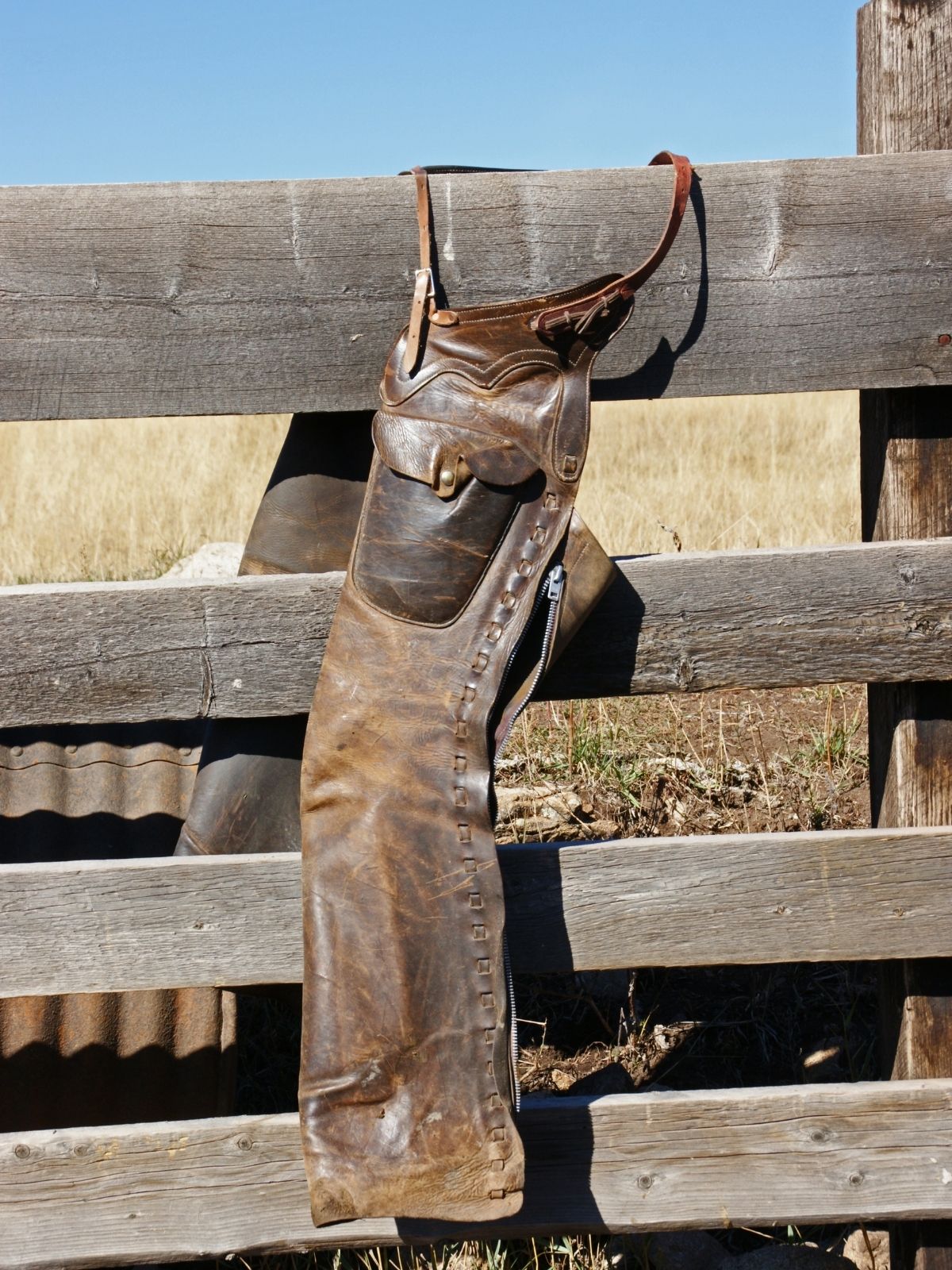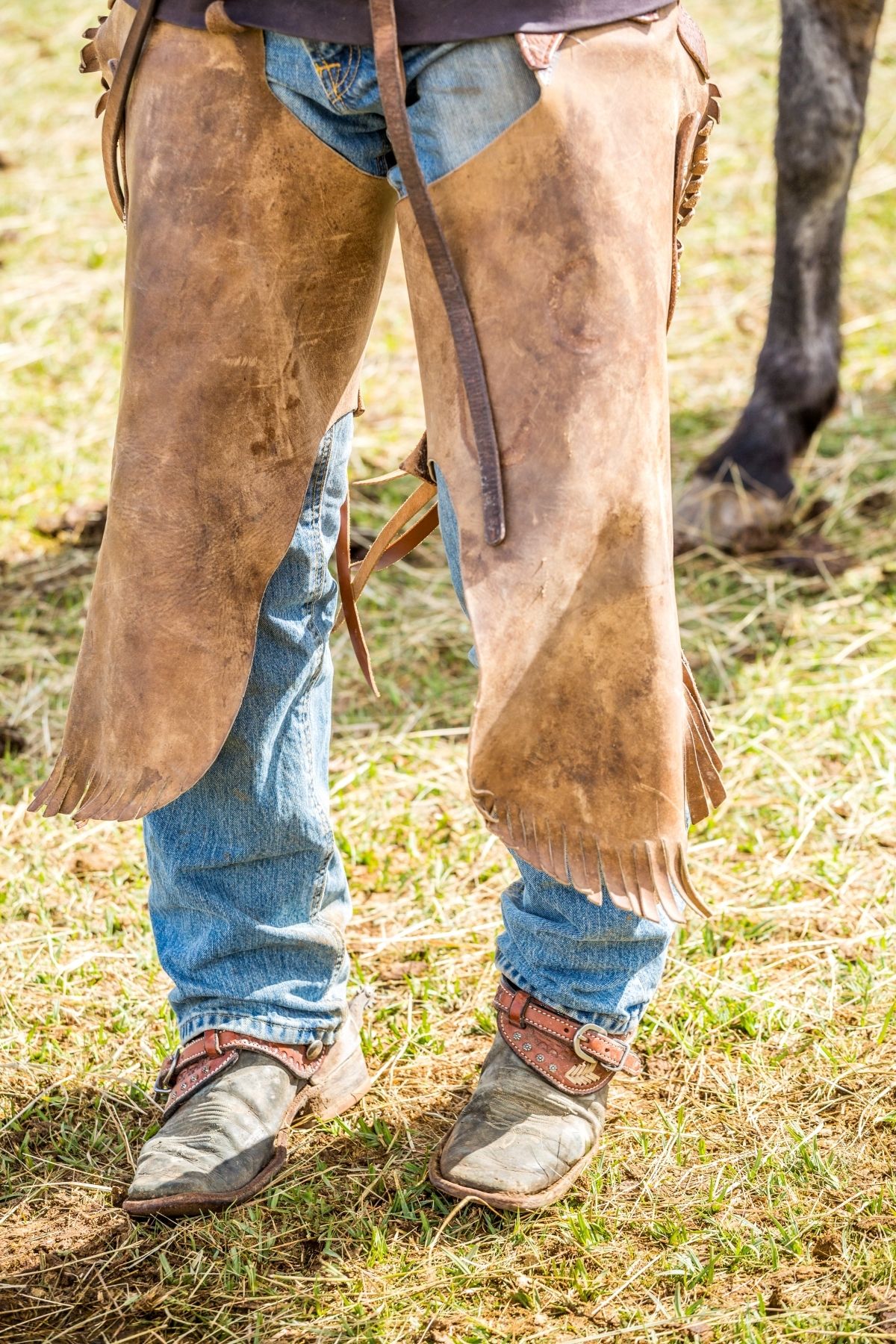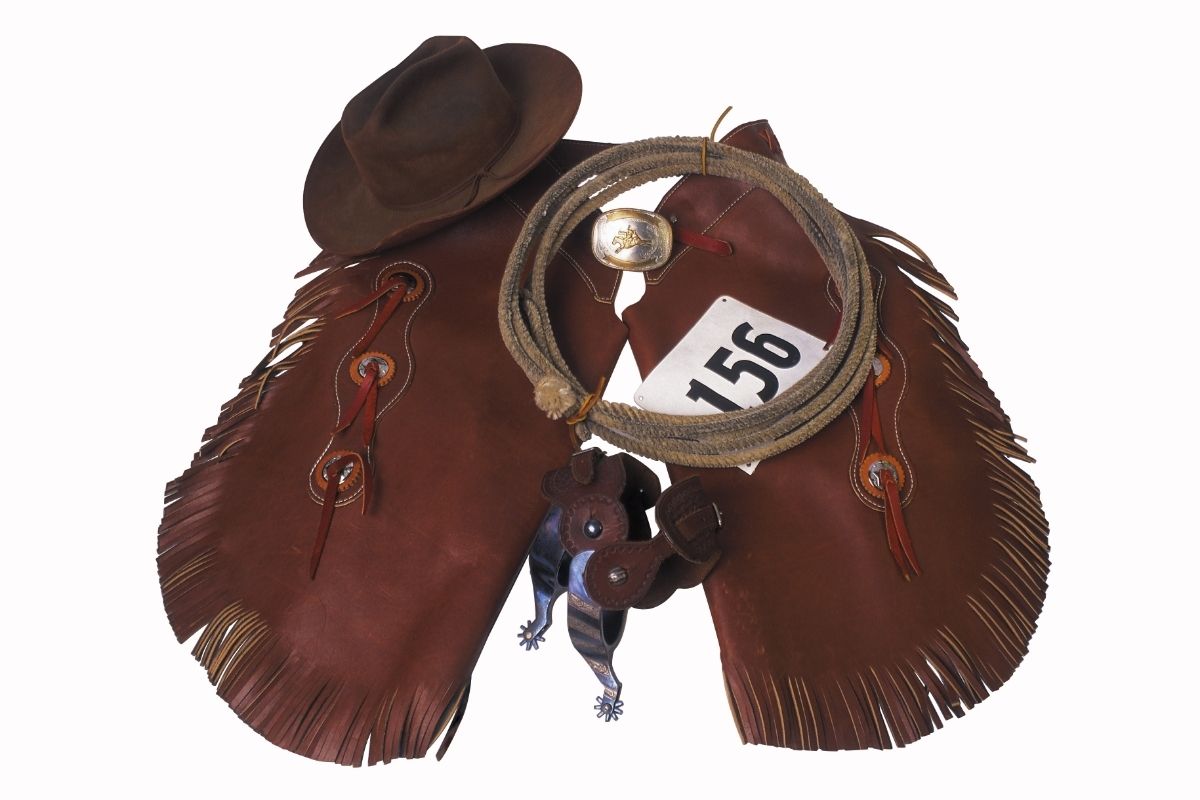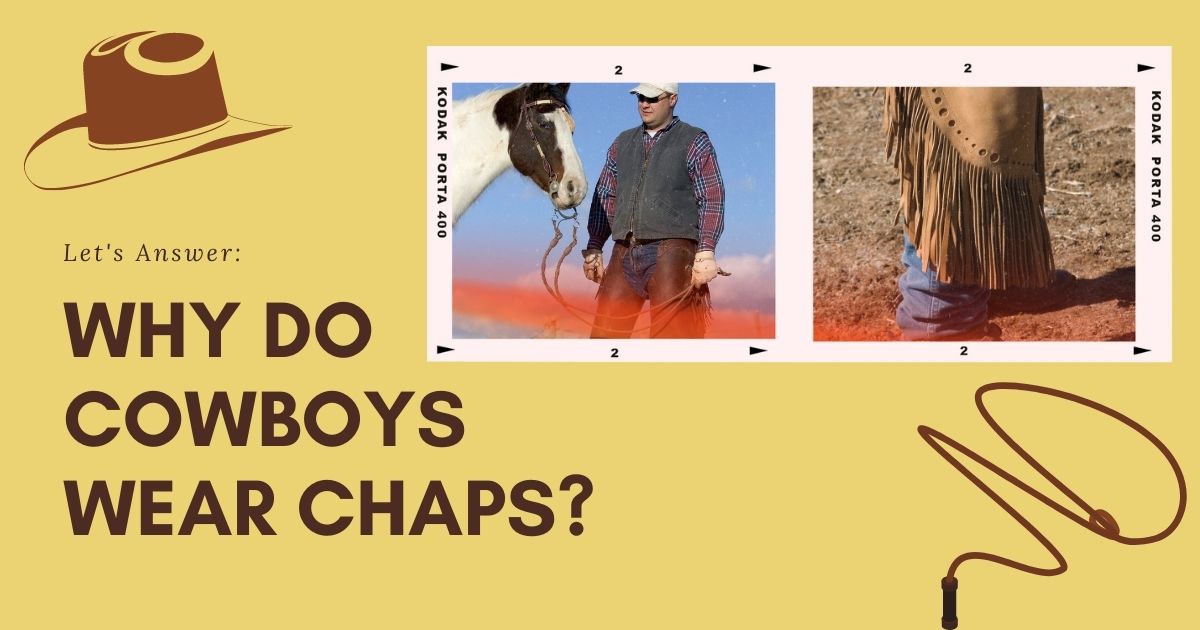What are Chaps?
Chaps are leg covers that people wear over pants, and people make them from a durable material kept together by a belt. But why do cowboys wear chaps? It’s a relatively common question and one that we’ll go over in greater detail in this article. But here’s a hint: they’re more than just fashionable cowboy pants chaps.
Please continue reading to learn why they exist and what cowboys use in riding. However, unlike other trousers, they do not have a covering at the bottom or crotch area.

What are Chaps Used For?
Now it’s time to get down to business. What is the purpose of chaps? Some advantages of wearing them are listed below:
Protection
When riding in dense places like forests or areas with many bushes, ranch chaps are good because they protect the legs from branches, brush (such as prickly pear), and thorns.
Stagecoach drivers, postal employees, military troops on horseback, cowboys on cattle drives, rodeo competitors, livestock laborers, chainsaw operators, motorcycle riders, and others have worn them.
When cowboys wear them for thorn protection, the leather is usually relatively stiff and has a round or flat seam running down the inside of each leg. One may pull the ranch chaps like a pair of breeches and readily remove them if necessary because of this.
Chaps not only protect the cowboy’s legs from thorns, but they also protect them from livestock and rope burns, which a standard pair of trousers cannot do.
Comfort
Another reason to wear chaps while riding is that sitting in a saddle for long periods can be painful, especially on horses with bony withers.
The stiff leather or other material used to make the chaps helps cushion the leg against the hard places where it comes into contact with the horse’s back. A cowboy in chaps will hence be comfortable while riding.
Warmth
As previously stated, cowboys may labor all day, and in some seasons, such as winter, it may be too chilly to spend the entire day on a horse. Regular leather chaps keep the cowboy warm by trapping air inside his body. This air insulates the space, reducing heat loss. Others may get composed of wool or padded with it.
Keeping Your Clothes Clean
Working with animals all day exposes you to various stains and grime. These stains can be challenging to get out of clothes. Even if you could remove them, the stains and spiky vegetation would still inflict damage to your clothing. The chaps ensure that most grime gets kept out of the clothes, preventing them from harm.
Why Do Cowboys Wear Chaps?
Chaps make riding more pleasant and protect riders from thorns, plants, and other hazards they may encounter while out on the trail. Depending on the chap you’re wearing, they can also give warmth in cold locations and reduce sweating in hot situations.
Are all Chaps Assless?
Depending on the situation, the chaps might be “full,” “half,” or “trouser-style.” The first chaps were full-length trouser-style chaps that cowboys and girls wore like pants. They were unwieldy, heavy, and I’m sure there was a lot of “monkey butt”!
The “ass-less” version was significantly superior; utilizing only the necessary amount of leather made them far more comfortable, lighter, and less expensive! They were made even more adaptable with the addition of straps and buckles. So, not all chaps are assless!
Chinks Vs. Chaps-the Difference
The chinks of a cowboy are comparable to chaps. Chaps and chinks are leather leg coverings used by horseback riders, most commonly cowboys and cowgirls, to protect their legs from the elements, lumber, brush, kicks, rope burns, and other dangers.
Chinks and chaps get fastened about the waist and have an open rear to allow one to see the rider’s seat. While chaps cover the entire length of a cowboy or cowgirl’s leg, chinks are shorter, extending just below the knee but stopping short of the ankle.
Shotgun and batwing are the two most popular chaps styles.
Shotgun chaps were the first form of cowboy leg covers. They cover the entire length of the leg and are usually closed from top to bottom.
Modern shotgun chaps usually have a zipper or other fasteners going from the top of the leg to the bottom to make them easier to put on and take off. Batwing chaps followed shotgun chaps.
Batwing chaps run the length of the leg as well but are typically only closed around the leg from the top of the chap to just above the knee. People frequently use buckles, snaps, and other types of fasteners. Batwing chaps have a broader cut than shotgun chaps, with many leathers overlapping the leg.
On the other hand, chinks are similar to chaps, except they are shorter, falling just below the knee but above the ankle. Snaps, buckles, or other fasteners secure the chinks around the rider’s legs, but the fasteners end above the back of the knee, enabling the chinks to move more freely from that point below.
Chinks’ fringe is frequently more prolonged and more conspicuous than chaps’ fringe (except for bronc riding or bull riding chaps).

Why Do Bull Riders Wear Chaps?
Chaps, particularly leather chaps, keep them comfortable and prevent them from sliding while riding the bull. In the event that the rider falls off, they can also help to prevent injuries. Because bull riding is one of the most dangerous sports, having an extra layer of protection is beneficial.
A Brief History On Cowboy Chaps
Since the design’s inception, the chaps we see today have undergone numerous changes. The first Western cowboys needed a solution to protect their pants and legs when capturing escaped cattle in the early 1500s. This was when the Spaniards were importing cattle from Cuba to Mexico.
The initial design was a permanent big leather cloth fixed to each side of a horse’s saddle pack, which the Spanish called armas. Armitas, a similar style that emerged about the same time, was constructed of two pieces of buckskin and hung from the belt. They then used leather straps to secure them around their legs.
These armitas (Spanish for “little armor”) evolved into the “chinks” style of leg coverings we know today.
As the Spanish ranchers made their way north, many changes occurred to the leg coverings to accommodate the changing climate, but Texas cowboys invented the first genuine chaps in the early 1800s.
The Different Types of Cowboy Chaps
Shotgun Chaps
This style gets made of two leather pieces held together by a belt and has a closed leg position, similar to seatless pants. They frequently featured outside pockets for the riders. They were also known as “shotguns” because they resembled double-barrel shotguns.
Originally designed to be loose-fitting for comfort, “shotgun” chaps, also known as “stovepipes,” are now commonly seen as having a snug fit at horse shows. These chaps do a better job of trapping body heat and keeping the rider warm in snowy or windy conditions, but they aren’t for humid conditions.
Woolies
There was also a “woolies” variation of this style, thicker and made of fleece or cowhide hair. These were commonly seen in the Rocky Mountains and Northern Plains during cold, harsh winters to keep the legs warm.
Chinks
Chinks also make good aprons for protection. As a horse-shoeing chap, one can use a more specific style of chinks.
Ranch Batwing chaps/Rodeo chaps
These are more breathable and flexible than shotgun chaps. They’re ideal for riding in the summer heat.
Materials Chaps are Made From
Cowhide makes equestrian chaps, except for woolies. Zamorros, woolies, and a few other traditional or ethnic styles can be produced with the hair or wool still attached to the hide, which is commonly cowhide, sheepskin, or Angora goatskin. They also featured seals, bears, and buffalo in the past.
Tanned and colored leather for chaps is frequently “split” so that it is supple, and one may turn it into a garment that allows for easy movement. A rough side, now known as suede or “rough out,” exists beside a smooth side. Both “rough out” and “smooth out” (smooth side out) designs are available for chaps.
Most batwings and chinks are smooth side out, whereas most shotguns are suede or rough out. Lighter, synthetic fabrics like Ultrasuede and vinyl may get used for horse shows, where styles may change from year to year, and durability is less of a concern. Yet, leather suede or a smooth split predominates due to durability and proper fit.
Except for Armitas (which have no metal pieces), most chaps feature a small metal buckle in the front to fasten around the waist and lacing on the back of the belt area to allow size adjustment. A few designs lace up the front and buckle up the back, but they aren’t very common.
Some variants, especially the batwing form, contain straps and small metal buckles or snaps on the sides to secure the legging around the rider’s leg. You may use full-length heavy-duty metal zippers in other designs, mainly shotguns. Instead of a front buckle, some medieval riding chaps employed a single break-away leather thread or lace.
Except for batwing designs, most chaps include a fringe down the leg’s edge, which is usually the same leather as the legging, though you may occasionally add a contrasting color of the leather. You can also find fringe on the bottom of the leg of Chinks and Armitas.
The belt that fastens a pair of chaps might be the same color of leather or a different color. Add ornate leather designs or fancy stitching to the bottom of the leg or the belt. You can also use sterling silver buckles and spherical decorative metal conchos to cover the buckles.

Parting Words
That’s all there is to it. So, why wear chaps? Chaps do more than making a cowboy enticing. They are protective leather clothing that shields them from all dangers they may encounter when out in the open. Even better, there are many styles of chaps that are ideal for a variety of hobbies other than riding.
